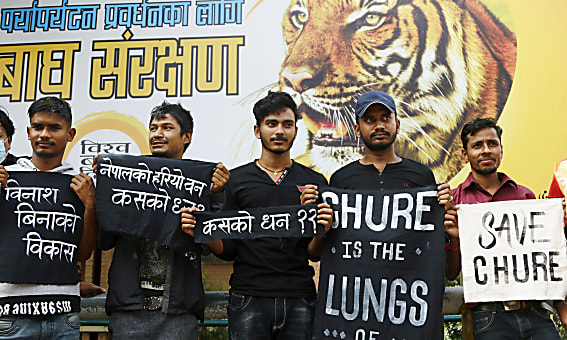
Kathmandu, Aug. 20 -- In Chandra Kishor Yadav's village in Dhanusha, sources of water have all but dried up. Over the past few years, wells, hand pumps and ponds have gone dry in Paudeshwar village of Aurahi Rural Municipality.
"The problem has gone from bad to worse in the last three years," said Yadav, who was among a dozen villagers from the Tarai districts protesting at Maitighar Mandala on Monday to draw the federal government's attention to the problems they've been facing due to uncontrolled exploitation of the Chure range, which stretches east to west below the Mahabharat hills.
"Degradation on the northern belt of the Chure region is to blame for the growing water shortages in the village," said Yadav. "We decided to come to Kathmandu after the local authorities failed to address our concerns."
Unabated exploitation of the Chure range for natural resources-riverbed materials, forest products and timber-have weakened this ecologically significant zone, adversely impacting the people living in its foothills.
Unchecked degradation of the fragile Chure range over the years has resulted in the drying up of water resources, annual flooding, and seasonal drought, among other natural disasters.
"Everyone is aware of the impact, but no one really cares. We are a small number but we hope that our voice will be heard sooner or later," Yadav said. "There was a flood this year. Sediments carried by floods down the Chure hills are deposited in our fields. If this continues every year, our land will turn barren and there will be no food."
Protesters also criticised the government's plan to construct an international airport in Nijgadh by felling nearly 2.4 million trees, leading to a loss of biodiversity, valuable wildlife and their habitats.
Conservationists fear that construction of the airport at the proposed site, which is below the Chure range and has already seen exploitation, can cause irreparable damage to the region's ecosystem, flooding the districts downstream and causing water sources to dry up.
Eight companies from seven countries have expressed their interest in building the $3.45 billion dollar project.
On Monday, protesters were joined by environmental activists and students from Kathmandu, demanding that the authorities rein in exploitation of the Chure range and put a halt to the plan to cut down trees for the airport project.
"All these years, various governments have only cut down trees in the name of development," Ramesh Kumar Yadav, a student from Saptari who is currently studying in Kathmandu, told the Post. "Deforestation over the years has caused effects like the disappearance of birds, rise in temperatures and floods in the Tarai. Instead of planting trees, the government is planning to axe more trees."
Binod Bhatta, an environmentalist and leader of the Chure-Tarai Madhes Conservation and Management Master Plan Preparation Team, said that the residents' visit to the Capital shows their growing awareness of the need for Chure conservation.
"It's a praiseworthy step by the locals. This also shows that they are finally realising the significance of protecting the Chure range," said Bhatta. "Chure degradation is happening in the upper belt but the impact is felt downstream. It is important to build pressure on the three levels of government to stop Chure exploitation. It is unfortunate that we have to hit the streets even to get an attention."
Protesters on Monday demanded that the government keep the Chure range free of human settlements, stop excavation of riverbeds, set up a separate force to protect the Chure range, and stop projects like the Madan Bhandari Highway and the East-West Railway which will traverse the Chure range and cause more devastation.
Degradation of the Chure range and its nearby areas has also been blamed for annual flooding in the districts below.
"Deforestation has continued for decades now," said 50-year-old Achchhelal Sah from Kalaiya, Bara. "These days, we face an acute shortage of water during the peak summer and too much water on rivers, which gushes into settlements, during the monsoon."
The Chure range, which occupies about 12.78 percent of the country's total area as the inner Tarai, the Chure hills and the Bhavar plains, has suffered years of deforestation due to migration from the hills, overgrazing, logging, and excessive mining of construction materials like boulders and gravel. Growing population and unchecked human activities have only affected the region further, impacting the livelihoods of the people living downstream.
"Chure is a lifeline for people from the Tarai districts," said Yadav. "It must be protected."
***
What do you think?
Dear reader, we'd like to hear from you. We regularly publish letters to the editor on contemporary issues or direct responses to something the Post has recently published. Please send your letters to tkpoped@kmg.com.np with "Letter to the Editor" in the subject line. Please include your name, location, and a contact address so one of our editors can reach out to you.